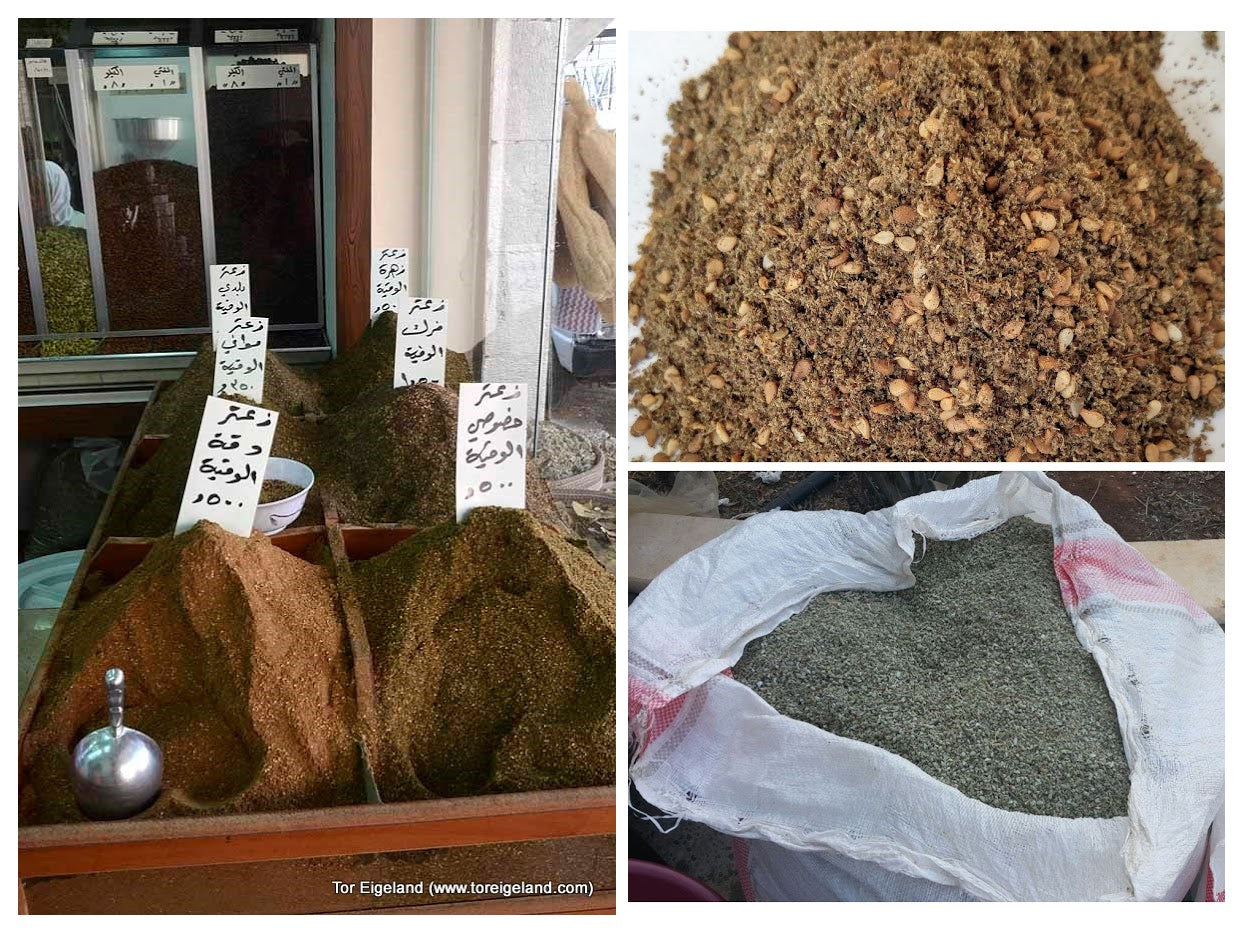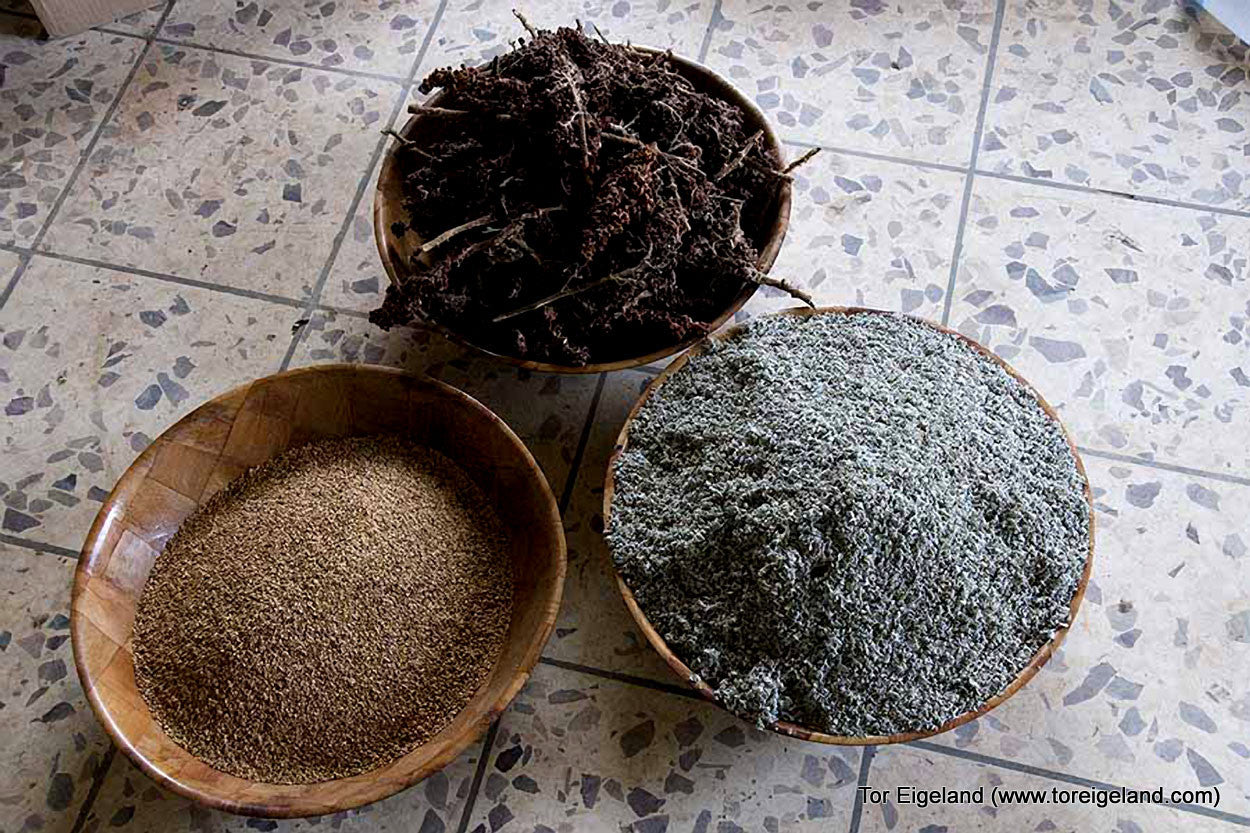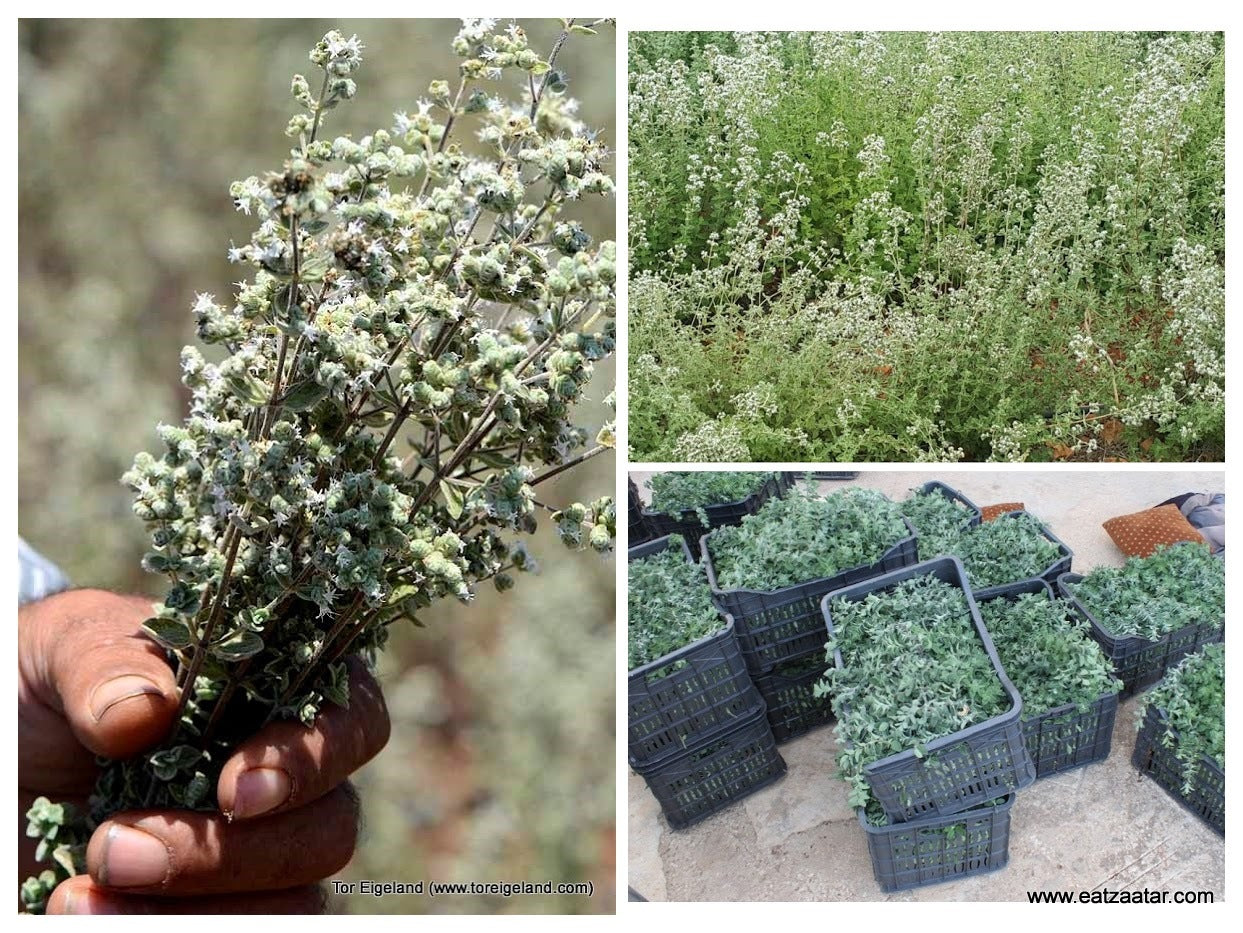What is Zaatar?
Zaatar or Za'tar (zaah-tur) is a common noun in the Arabic language and refers to both a Middle-Eastern herb spice mixture and importantly a distinct herb plant in the mint family. The herbal plant is referred to in English as bible hyssop or Syrian oregano, but the mixture is just called zaatar.
Zaatar enjoys an enduring heritage in the Levant/East Mediterranean region as an essential kitchen table staple because it is simple, delicious, nutritious, and offers many relishes. It is a condiment that is often enjoyed as a dip with olive oil and bread, a topping on flat breads and bakery items, a seasoning and a herbal spice on many foods.
Zaatar's reputation however may be increasingly confused by the increasing number of seasoning mixes on the market claiming the zaatar title. While these seasoning mixes may be tasty, they often are different from the taste and nutritious ingredient profile of an authentic zaatar mix. Zaatar's middle eastern standards allow slight variations in flavor profiles but is strict on mainstay ingredients and overall taste.
The mainstay ingredients of authentic zaatar the mix, include 1) the ground Zaatar herb with the scientific name of Origanum Syriacum1 which is native to the Middle-East and is believed to be the same Hyssop herb plant in biblical references 2 and combines earthy flavors from thyme, oregano, marjoram, and savory with a peppery finish 2) Sumac powder spice (lemony but without the acidity), and 3) sesame seeds roasted (nutty, crunchy) 4) optional pinch of sea salt. The texture of an authentic mix should not be that of a fine spice powder, but more course, herbal, fluffy and free flowing, and somewhat nutty from freshly roasted sesame seeds.
The easy way to try Zaatar is the Middle Eastern traditional dip with olive oil - dunk fresh bread in quality olive oil then dunk the oil-soaked bread in the Zaatar. Also, a popular and traditional Zaatar flat bread recipe (Manaesh or Manakish), in Middle-Eastern bakeries is spreading a pasty mix of olive oil and Zaatar on flat breads or pizza dough and is best served piping hot out of an oven (optional toppings may include chopped fine tomatoes, onions, mint leaves), .

Because Zaatar is an aromatic, zesty, tangy, lively, and nutty herb and spice blend, it quickly becomes apparent that Zaatar is a versatile condiment that may season and be sprinkled on many foods. Examples include bagel and cream cheese, yogurts, salads, vegetable, eggs, meats, fruit, popcorn, and others.
More recently, Zaatar has experienced creative culinary incarnations in North America beyond its traditional uses in the Middle East. There are a variety of vegetarian and salad Zaatar recipes that use Zaatar as a dressing, as well as recipes as a rub on certain meats for seasoning and crusts.
What makes Zaatar special is its simplicity. It is non-perishable and can simply remain in a pinch dip bowl along with the olive oil on kitchen counters to be enjoyed anytime as side food, a condiment, or main meal with bread and olive oil when there's nothing else to eat!The zaatar herbal plant, which is the mainstay ingredient in a quality mix, also makes a soothing herbal tea drink that is therapeutic, according to folk medicine in the Levant region but supported by medical research

Zaatar recipes vary somewhat but the taste should be recognizable
We believe that the 'zaatar' title is increasingly misused in the marketplace to claim taste profiles and ingredients that have little relation to an authentic middle eastern mixture. On many food blogs and product listings today, we often read that there are numerous zaatar recipes which may imply an absence of standards for taste or quality. We suggest that this is not true. There are recipe variations but there is only one zaatar taste that should be recognizable. The recipe differences between various authentic mixes is not so much in kind (overall taste) but in degree (added spice flavors and ingredient grade qualities).
For example, when the mainstay zaatar herb (Hyssop/Origanum syriacum) ingredient is not available or not affordable, substitutes are used to mimic the taste. Zaatar mixes with substitute ingredients may include a combination of thyme, oregano, marjoram but with varying degrees of quality and flavor intensity. Many commercial brands also add fillers like wheat or often unknown fillers to increase volume and lower cost (ground straw is not uncommon in very low quality mixes) The lemony and bright Sumac spice ingredient is very important also to an authentic zaatar taste. Zaatar cheats use citric acid as substitute for genuine Sumac. Freshly roasted sesame seeds are also important flavor and texture ingredient.
Recipes of zaatar mixtures in the origin Levant countries (Syria, Palestine, Israel, Lebanon, Jordan) may include one or more of the following fillers (often to lower cost) and spices : ground wheat, ground peanut, ground chickpeas, ground peas, ground cumin, ground fennel, ground coriander, ground caraway, ground anise seed, ground roasted melon seed kernel, ground roasted watermelon seed kernel, ground roasted hazelnut, dried pomegranate seed, and others. Of course, there are differences in qualities and grades of any ingredient used in terms of flavor intensities, freshness, and possible contaminants (microorganisms such as salmonella, ecoli, others or heavy metals such as lead, mercury, others)
To raise the standard, we believe, for a quality zaatar mix, we invite you to try the Tyme Foods brand, conveniently sold here or on Amazon.

The Zaatar Herb (Hyssop) Plant – Distinct Specie Native to the Levant
The herb plant Zaatar is believed to be the same specie as the biblical hyssop. The scientific name is Origanum Syriacum (also known Majorana syriaca) which is in the Origanum genus under the Lamiaceae (mint) family plant kingdom rank1. There are other strains under the Lamiaceae mint family such as Thymus serphyllum, native to Northern Europe, and known also as wild thyme, and Thymus vulgaris native to southern Europe and known as English thyme, as well as others. However, Origanum syriacum, or Zaatar herb, is native to the Middle East. It is a short shrub of up to 2.5 feet. It is characterized by its small white flowers and very fragrant cottony leaves. Like many herbs, flavor is determined by the essential oil content of the herb. With Zaatar plant leaves, a high or low content of the thymol and carvacoral essential oils along with other compounds drives the flavor intensity. Within the cultivation regions of the Middle East, essential oil content of the zaatar leaves varies significantly because of different soils and cultivation practices, and range from few to forty grams, per kilogram.

Effortful Processing of the Zaatar Herb Plant Yields Higher Qualities
The Zaatar herb plant is harvested during the summer months and washed in water to clean its velvety leaves of accumulated soil dust. It is left to dry outdoors in the shade for days, after which it is packaged in bundles which are then left to rest indoors for one or two weeks until they are completely dry. The leaves of the dried plants are separated from the stems with aid of basic hand tools or by hand. After the separation process, the product is gathered and sifted first in wider sifters that removes the stalks from the leaves, and then in finer sifters which separate small twigs and larger leaves from the small leaves. In lower quality zaatar mixes, the stalks and steams are ground are used along with other fillers. Plants used in high quality zaatar mixes are additionally sifted and picked by hand and may also undergo an air blower process to rid the leaves of the cottony velvety layer. The Zaatar plant is part of the middle eastern culture because the plant has grown in the wild for as long or as old as the hills there. In recent past, it also has been cultivated in farms, and may be cultivated anywhere with Mediterranean climate. However, because Zaatar plant processing is very labor intensive, it continues to favor the Middle East region because of its lower labor costs..

Health benefits of zaatar the herb plant (Origanum syriacum)
The zaatar herbal plant has always been integral in folk medicine therapeutic prescriptions in middle eastern cultures. Academic research (3) has been conducted over the years and have confirmed medical properties of Origanum syriacum, which is the scientific name for the zaatar plant. According to this review of medical studies, the plant's richness in essential oils offer antimicrobial efficacy, anti-inflammatory efficacy, antioxidant activity, and antitumor efficacy. One option to enjoy the health benefits of Origanum syriacum is with Tyme Foods’ soothing herbal Thyme tea.
References
- Missouri Botanical Garden Plant Finder
- Identification of biblical hyssop and origin of the traditional-group herbs in Mediterranean region
- Mohamad, Ranim et al. “Prospects for using Origanum Syriacum (L.) as a source of antimicrobial agents.” Journal of advanced pharmaceutical technology & research vol. 12,4 (2021): 340-344. doi:10.4103/japtr.japtr_106_21
